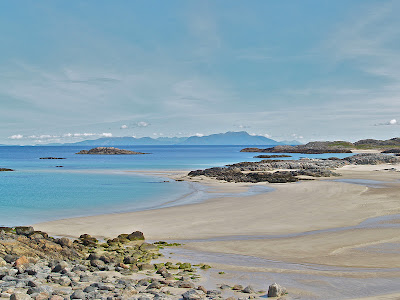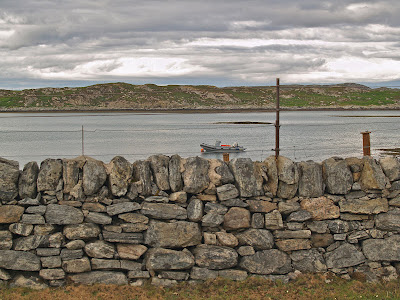 |
| View of the small isles |
Coll is that special place, a Hebridean island that escapes the maddening crowds and has a sunshine record that makes Devon and Cornwall seem dull. We spent five days there this week sailing from Oban down the Sound of Mull and across to the low-lying slab of Lewisian Gneiss that is Coll. It was once part of the Canadian shield before continental drift separated these geological cousins. In the nineteenth century, many folks from Coll repeated the drift and emigrated to Canada.
 |
| Lobsterville |
 |
| Heart and soul of Coll |
 |
| Just take a bike |
 |
| Above Arinagour |
|
|
Arinagour in the late evening
|
 |
| Arinagour from Coll Hotel |
 |
| Midsummer evening |
 |
| Sunset over Mull from Arinagour, Ben More prominent |
 |
| Toraston Beach with Rum on the horizon |
 |
| Cornaig beach |
 |
| Greylag goslings at Ballyhough |
 |
| Diamond Jubilee beacon |
 |
| Gneiss rocks, even older than old red sandstone |
 |
| Gneiss Wall |
Coll has always been Aileen's favourite island but it has been nine years since our last visit. The population has almost doubled to 220 persons over the past thirty years and a primary school roll of 38 pupils makes it a child-rich island. There have been quite a few private houses built in this period although the planning decisions seem a bit arbitrary. The cottages on the main street are mainly holiday homes and as such deny the village of Arinagour the buzz of a thriving community.
The island has become more diverse with the Collach diaspora returning to raise families and giving Coll the energy and aspiration of younger people in contrast to the sense of people living out their years that was evident 20 years ago. Land ownership is now spread amongst a far wider range of interests than that of the Laird, and the Dutchman is no longer the dominant influence.
The Coll Hotel is one of the best, with local produce dominating the menu and it acts as the heart of the community along with the Post Office, the Cafe and the shop. Accommodation is sparse with one good B&B at Tigh na Mara and a superb new bunkhouse that opened this week and provides 16 beds. It is part of a complex that includes a new Community Centre costing over £2.2m. The inspiring new Community Centre is to open in July but it will be a challenge to sustain such a large building in competition with the warm and lively informal meeting places of the Hotel and Cafe.
Jobs are still scarce and arguments are raging about an application for a salmon farm from the Norwegian global company, Marine Harvest, which will bring about 10 permanent jobs. There is also a fierce debate about a community wind turbine which is to be resolved by a ballot - never the best way to resolve this sort of issue. It requires flexible minds and reconciliation not retribution in a close-knit community. There is a lack of new affordable housing for locals and the local housing association seems to be a bit tardy in addressing this issue.
The greatest attraction for the visitor is the outstanding landscape including some of the most beautiful beaches in Britain and bird life that ornithologists dream about. The bedrock of Lewisian Gneiss with its glorious colours and bandings is covered by sand dunes and elsewhere by bogs that are covered with yellow flags at this time of the year.
The island suffers from super slow broadband but as several islanders told us, the lack of water makes Scottish Water even less popular than BT. Mobile phone reception is intermittent but the airport is user-friendly for the short hop to Oban. Surprisingly, CalMac ferries were thought to be reliable and customer friendly and that was certainly our experience. The ferries from Oban not only pass through mesmeric scenery with unforgettable views of the Small Isles (Rum, Eigg and Canna), but they are well-appointed and comfortable. What better way to spend 3 hours escaping the dreary tedium of urban life. Coll just urges you to slow down and be happy.
The roads are single track and the cambers are capped with clover and other rock plants. The ditches are filled with the rasping of Corncrake. The white-shell sand beaches and rocky shores are littered with seals and host more otters than people. Coll is proud of its lack of signage, everyone knows everyone and everywhere. Despite a Gaelic tradition, there is an absence of spoken Gaelic and certainly no road signs in Gaelic like those that now festoon and confuse road users on the mainland. The Free Church which dominated and restricted island life forty years ago was challenged by a group of formidable young mothers and is now up for sale. Sunday is free instead.
Coll was once famous for its cheese, a great favourite in the Houses of Parliament, but it is no longer in commercial production although there are still some dairy herds. Cheese making is bedevilled by onerous food standards regulations and sadly there has not been the blossoming of micro creameries on a parallel with the microbreweries which have regenerated the art of beer making and drinking. Peat is still cut and the remains of a bonfire were still burning the peat on the hill above Arinagour three weeks after the Diamond Jubilee beacon was fired up.
Unlike some other islands, most notably Eigg and Gigha, there is not a Community Trust to provide a proactive drive to the island. The Coll Development Company has focused almost totally on building a new Community Hall and this has diverted attention from developing a more sustainable economy for the Collachs. The biggest employer is the Project Trust which provides gap year opportunities for young people to visit and train for work in developing countries. There are mixed feelings about its operation on the island. Most products are very expensive, as the fuel pumps testify, and there is an understandable high markup price of goods in the shop. There seems to be an undercurrent of understanding by the community that it must become more ambitious to support local produce and services if job opportunities are to be provided for its young people. Depending on tourism through Visit Scotland is tantamount to franchising its future to a distant organisation that appears to have no real feel for the island. Coll seems to understand that community/local websites are so much more effective than relying on those of top-down quangos like Visit Scotland.
Cycling around the island is the best way to travel and allows you to explore the beaches, inhale the mellifluous scented air and work up an appetite for the excellent food that the hotel and cafe provide. Coll is one of the few places people can drive without passing a driving test or a MoT. The fuel price is the highest in Britain but the cars come cheap and it is the Scottish equivalent of Havana with old models lacking MoTs brought back from the car auctions. We attended the last Ceilidh in the old community hall and were made welcome by the locals. Aileen met Marie Hedderwick and had a long chat, they had both spent time on Coll as girls in the 1960s. As we walked back in the early hours, the night sky was so dark with the absence of any street lights that Coll's application to become a dark sky discovery place should be a shoo-in. We were due to go to Tiree during our stay but with Coll in our veins, it seemed pointless.


















No comments:
Post a Comment
thanks